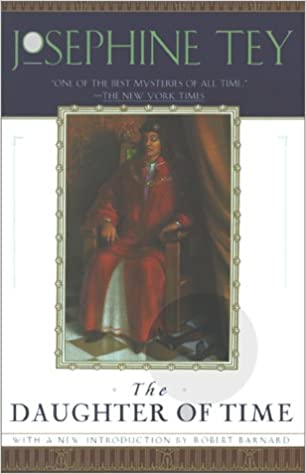
I’ve had Josephine Tey’s mysteries on my shelves for decades. Last week I decided to read one of Tey’s books and I chose The Daughter of Time (1951). Friends who have read Josephine Tey’s works rave about The Daughter of Time. Inspector Alan Grant of Scotland Yard, while recuperating from a broken leg, finds himself drawn to a portrait of Richard III. That fascination leads Grant into investigating the heinous crime Richard III is supposed to be behind: the murder of his brother’s children to protect his crown.
Clearly, investigating a crime hundreds of years old is the coldest of cold cases, but Josephine Tey provides Grant with the help of facts from the British Museum and an American scholar to clarify whether Richard Plantagenet was really behind the killings of the Little Princes in the Tower.
I confess I wasn’t expecting such a suspenseful tale with so much history behind it. After reading The Daughter of Time I wanted to drop everything and watch a performance of Shakespeare’s Richard III! Robert Barnard’s fine “Introduction” provides more insights into the book and the author. GRADE: A
The Tudor dynasty (with a string assist from first Thomas More and later Shakespeare) decided that Richard III was going to take the rap for the murder of the princes in the Tower, although Henry VII had just as much—even more perhaps—to gain from removing the last two legitimate male heirs (ahead of him) to the throne. There’s a historical fiction from the 1970s by Rosemary Hawley Jarman, WE SPEAK NO TREASON, which argues that there is plenty of evidence that the princes were still alive when Richard died. I suppose we’ll never know. As for Josephine Tey, I enjoyed several of her books, my favorites were THE FRANCHISE AFFAIR and A SHILLING FOR CANDLES.
Deb, DAUGHTER OF TIME surprised me with its detail and sophistication. I’ll be reading more Josephine Tey in the future. I have copies of THE FRANCHISE AFFAIR and A SHILLING FOR CANDLES on my shelves.
One of my favorites, along with her great book The Franchise Affair.
Patti, glad you’re back! Hope your power is back on!
I really should get around to reading this, but I love so much to think of Richard III as a stylish villain that I’d hate to tarnish his picture with innocence.
Dan, I’m with you on Shakespeare’s depiction of Richard III. Villains are more interesting than Good Guys.
What Deb said. Henry Tudor was the more likely person behind the deaths. Of course, this was parodied in the first episode of BLACK ADDER.
I’ve read Tey’s eight mysteries and always liked this one a lot. A very similar story was later told in Colin Dexter’s Gold Dagger Award-winning THE WENCH IS DEAD (1989), where Insp. Morse “solves” an 1859 murder from his hospital bed while recovering from bleeding ulcers. I am a big fan of mysteries that combined modern policing with historical cases, like these two books do so well.
Jeff, I have THE WENCH IS DEAD in my Read Real Soon stack. I like historical mysteries and police procedurals so a combination of the two is irresistible to me!
I read all of her books back in the 60’s and enjoyed them all. I should probably reread some of them again.
Steve, I’ve had Josephine Tey’s books on my shelves since the 1960s, but I’ve only gotten around to reading one of them last week!
A classic, surprised you didn’t read it decades ago.
Rick, over the next few months, you’re going to see me review books that I should have read decades ago…but didn’t until now.
Don’t forget Guy Townsend’s spirited opposition to this.
Bob, I had completely forgotten Guy Townsend’s brouhaha over THE DAUGHTER OF TIME! Thanks for jogging my memory!
Coldest of cold cases. That’s such a fine way of putting it:). Am looking forward to reading more reviews of books that you should have read decades ago.
Neeru, I just posted a review of my first Helen MacInnes novel: http://georgekelley.org/fridays-forgotten-books-657-horizon-by-helen-macinnes/